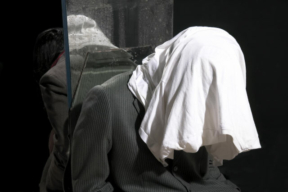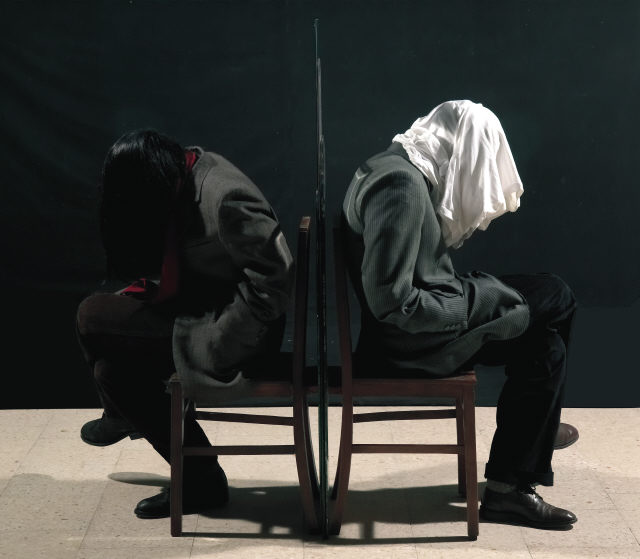
- 2003
- Shoes, Poliester, Mirror, Wooden chair, Garment and Resin
- A definir
- Inv. 04E1255
Noé Sendas
The Rest is Silence II
Two dressed mannequins, simulating real human beings on the same scale of the artist himself, are installed in a dark space. They are seated symmetrically in wooden chairs, with legs crossed, shrugged shoulders and dropped heads. The torsos almost come together on their backs, but they separate in a movement that bends the figures forward, as if the two bodies were being kept attached, but their minds attempted to obtain independence.
The symmetry and movement are accentuated on a mirror that stands between the two figures, demarcating the chair backs. In that way, when we look at each of the figures in front, the reflection we see on the mirror could be that of the figure that we know to be standing on the other side….
The clothing is ordinary and we could see it as the outfit of any man in the city: straight-cut dark pants, leather shoes, suit jackets identical to so many others, common elements to all the male wardrobe. Something differentiates the two mannequins: dark, long hair, hiding the face in one of the cases; a white cloth over the head, in the other. The faces remain concealed, which adds further mystery to an already obscure atmosphere.
The mannequins’ disposition provokes strangeness in the public, eventually fear – feelings that are motivated by the effect of hyperrealism alluded by Miguel Amado in Densidade Relativa (CAM, 2005, p. 259). The muteness involving these figures, the impossibility of communication that they represent, their averted or covered look are features that increase the aura of mystery surrounding them. Their presence is real in that place; the rest is silence.
AG
November 2011
| Type | Value | Unit | Section |
| Height | 700 | cm | |
| Width | 700 | cm | |
| Height | 140 | cm | |
| Width | 90 | cm | |
| Depth | 200 | cm |
| Type | Acquisition |
| Densidade Relativa |
| Lisboa, CAM/FCG, 2005 |
| ISBN:972-635-169-x |
| Monografia |
| Densidade Relativa |
| Leonor Nazaré |
| Curator: Leonor Nazaré |
| 27 de Outubro de 2005 a 22 de Janeiro de 2006 HALL de entrada e Piso 1 no CAMJAP |
| 12-8-2006 a 26-11-2006 Centro Cultural Emmerico Nunes e Centro das Artes de Sines |
| A ideia de trabalhar o conceito de densidade das obras começou por surgir com a constatação de que a palavra é muito frequente nos textos de crítica de arte. O mesmo acontece com a palavra intensidade que facilmente se associa à primeira. Rapidamente se percebe que densidade pode ser sinónimo de riqueza ou de impenetrabilidade, quando não se refere mais literalmente à acumulação de elementos no espaço, por oposição ao vazio ou à rarefacção. O pensamento em torno destas variantes conduziu à percepção de que o conceito poderia ser útil no estabelecimento de um contínuo entre a matéria do pensamento e a dos corpos e objectos, neste caso, a das obras de arte. |
| Exposição Permanente do CAM |
| CAM/FCG |
| Curator: Jorge Molder |
| 18 de Julho de 2008 a 4 de Janeiro de 2009 Centro de Arte Moderna |
| Exposição Permanente entre 18 de Julho de 2008 a 4 de Janeiro de 2009. |


